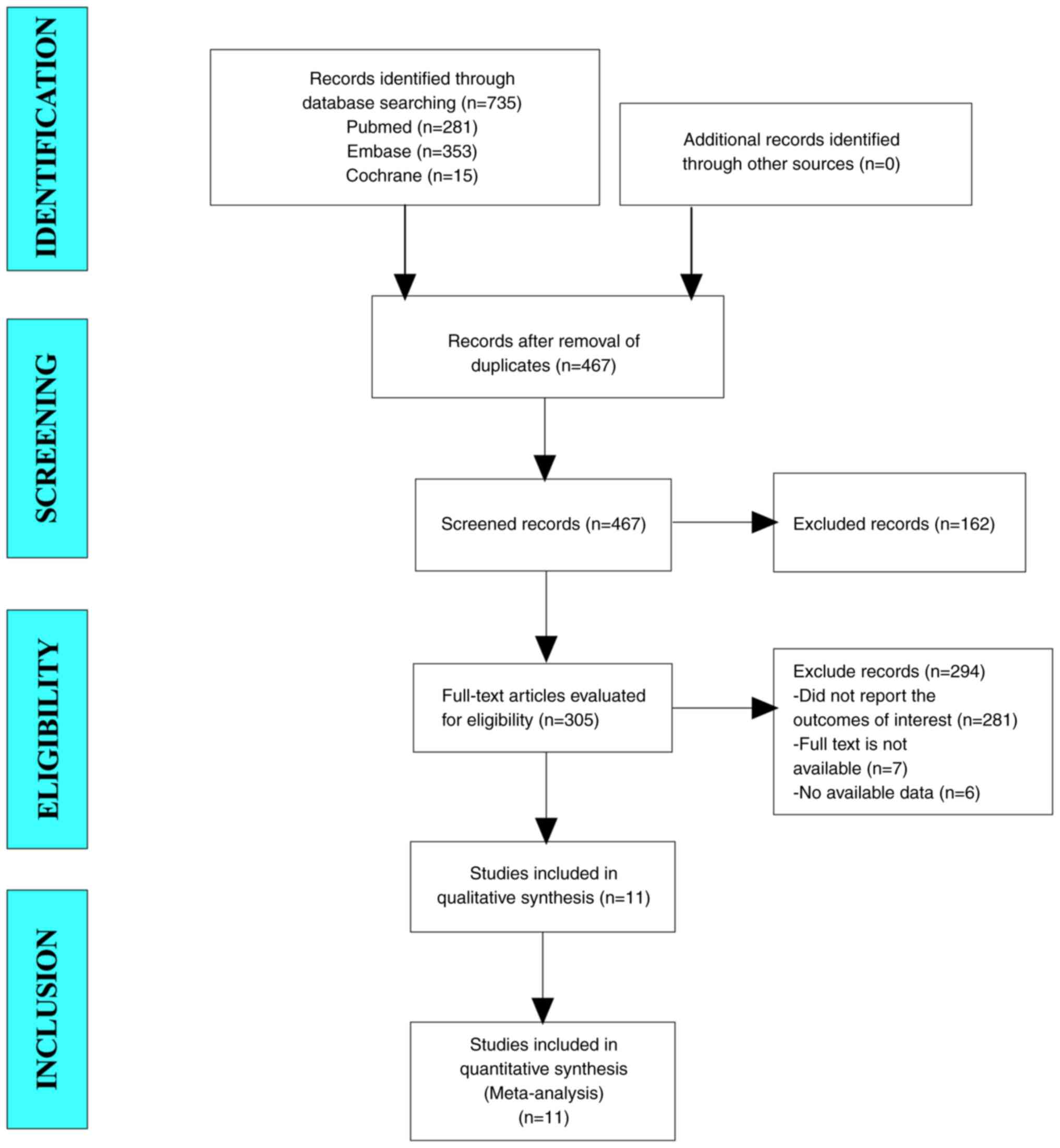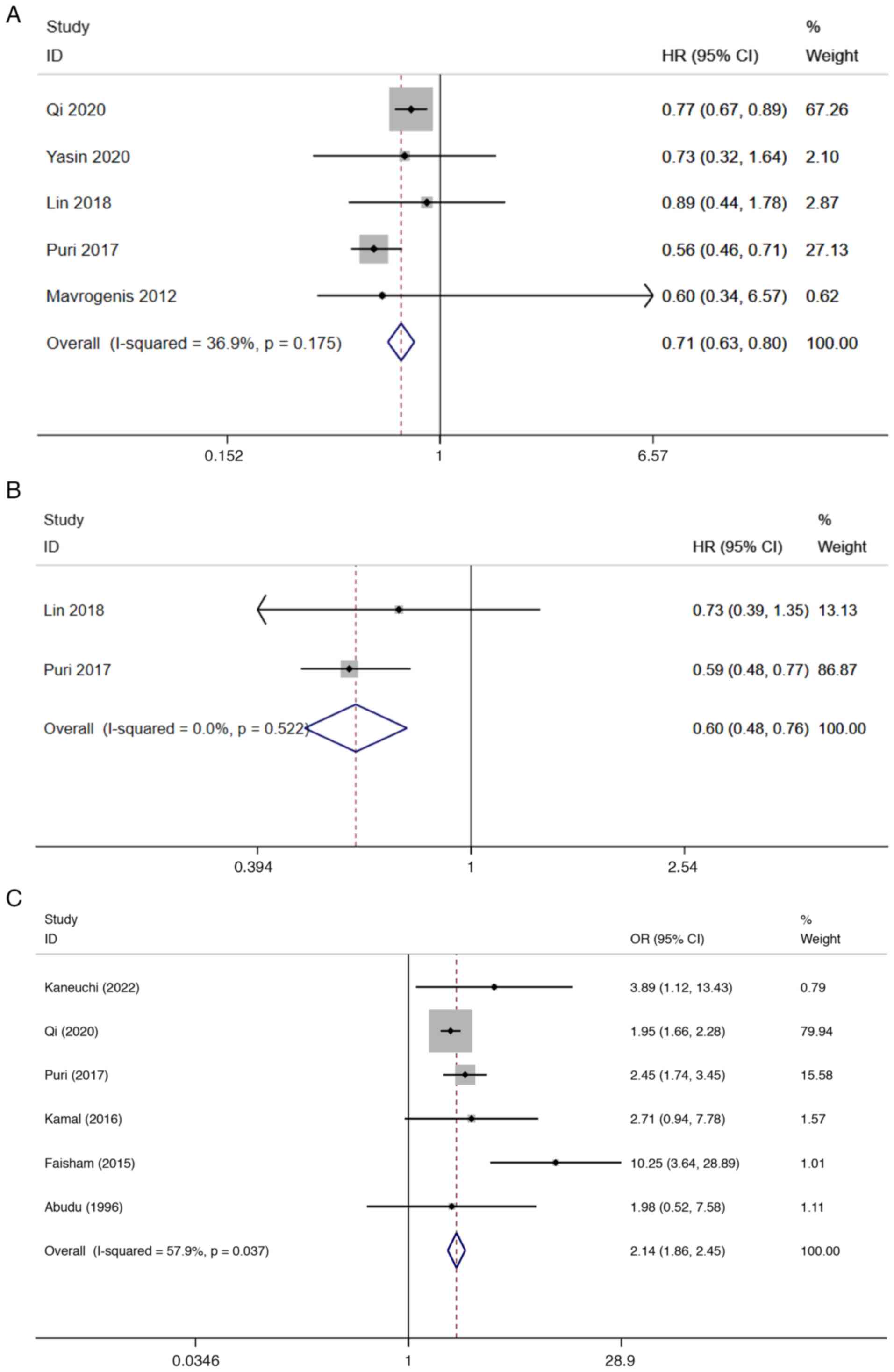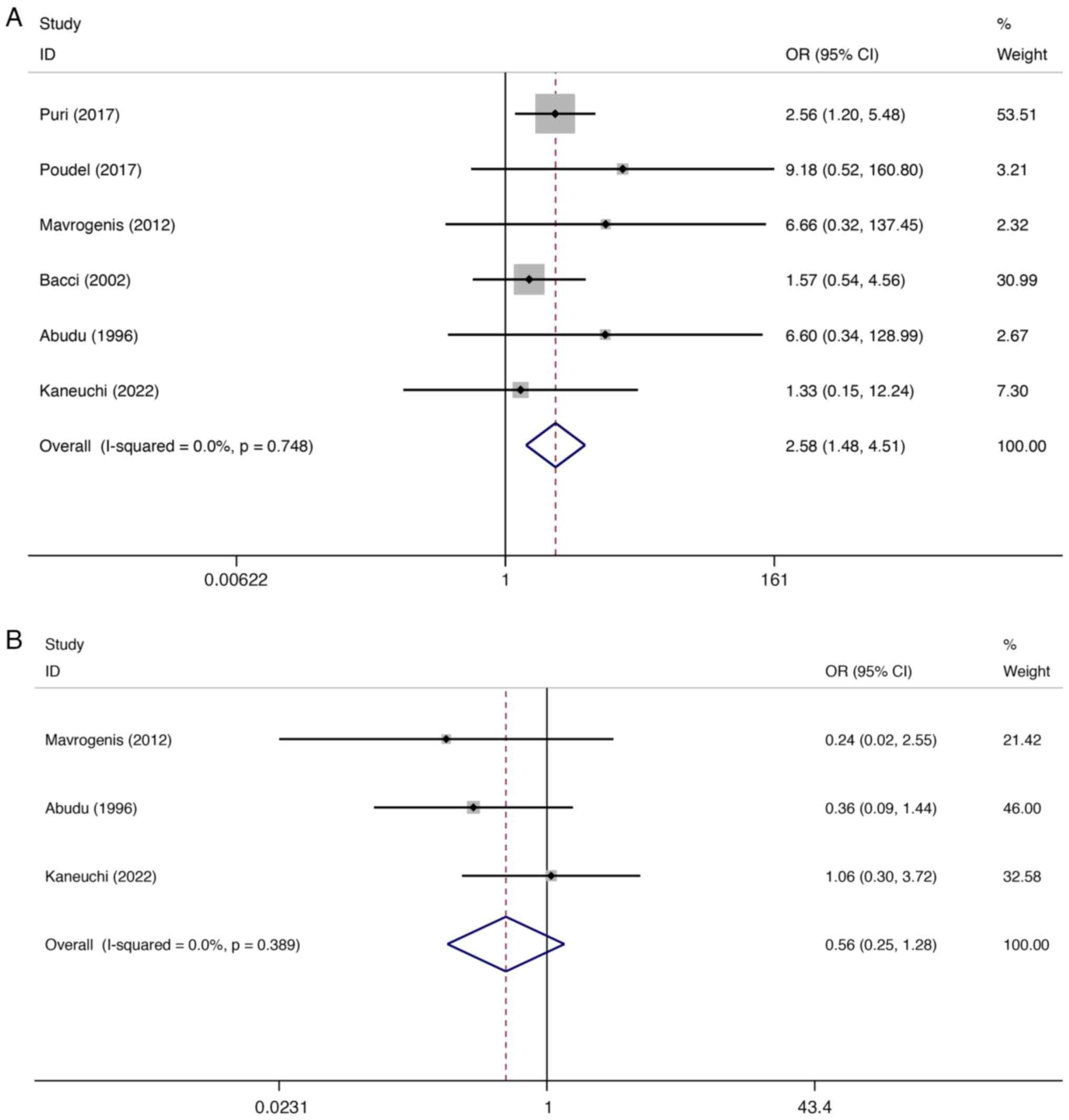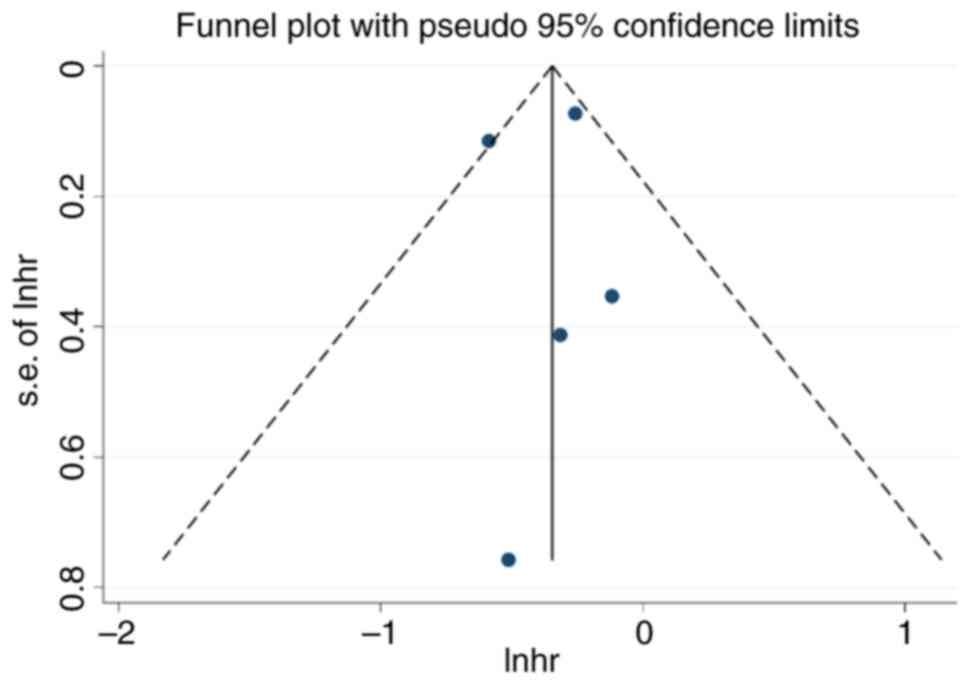Prognosis of limb‑salvage treatment of osteosarcoma in adolescent patients: a meta‑analysis
- Authors:
- Published online on: September 15, 2023 https://doi.org/10.3892/ol.2023.14053
- Article Number: 466
-
Copyright: © Wang et al. This is an open access article distributed under the terms of Creative Commons Attribution License.
Abstract
Introduction
Osteosarcoma, a primary malignant bone tumor originating from bone mesenchymal cells, is one of the most prevalent malignancies affecting children, adolescents and young adults (1–3). Despite its rarity, ~1,000 new cases are diagnosed in the United States each year (4). Osteosarcoma manifests in primary and secondary forms, together accounting for nearly 20% of all primary bone tumors (5). Characterized by its highly aggressive nature, osteosarcoma often metastasizes early, with the lung being the most frequent site for distant metastases. At the time of diagnosis, the majority of patients already present with lung micro-metastases, which serve as the primary cause of death (6).
Current treatment options for osteosarcoma include surgical procedures, chemotherapy, biological immunotherapy, molecular targeted therapy and other similar approaches. The five-year overall survival (OS) rate following comprehensive osteosarcoma treatment ranges from 66–82% (7). The standard treatment protocol typically involves neoadjuvant chemotherapy, followed by surgery and adjuvant chemotherapy (8). Increasing evidence suggests that limb-sparing surgery is gradually replacing amputation in the treatment of osteosarcoma (9,10). Nevertheless, some studies argue that early and aggressive tumor removal through amputation effectively prevents further fracture development, making it a preferable choice for osteosarcoma cases complicated with pathological fractures (11,12).
Han et al (13) conducted a meta-analysis of articles published before 2015, comparing amputation with limb-salvage surgery in patients with osteosarcoma, demonstrating higher five-year survival rates and improved functionality with limb-salvage surgery. Another meta-analysis published in 2022 compared the efficacy of limb-salvage surgery and amputation in patients with osteosarcoma treated with neoadjuvant chemotherapy (14).
The present study primarily focused on the effectiveness of limb-salvage treatment for adolescent osteosarcoma patients. By conducting a meta-analysis of the published literature on osteosarcoma surgical treatment, the goal was to systematically evaluate the clinical efficacy of both limb-salvage treatment and amputation in order to determine the most appropriate treatment strategies for adolescent patients. The current meta-analysis aimed to provide guidance for the clinical treatment of osteosarcoma.
Materials and methods
Guideline, inclusion and exclusion criteria for literature selection
In the present study, the PRISMA guidelines (http://www.prisma-statement.org/) were followed. Inclusion criteria were as follows: a definitive diagnosis of osteosarcoma and articles written in English. Exclusion criteria included duplicate publications, reviews, editorials, single case reports and studies without full text, incomplete information, or studies from which data extraction was impossible.
Search strategy
PubMed (https://pubmed.ncbi.nlm.nih.gov/), Embase (https://www.embase.com/) and the Cochrane Library (https://www.cochranelibrary.com/) were searched for relevant literature. The search period extended from the inception of each database to September 2022. The search terms used included ‘Osteosarcoma’, ‘Osteosarcoma Tumor’, ‘Osteogenic Sarcomas’, ‘Limb Salvage’ and ‘Amputation’. Specific search strings for each database were as follows: PubMed: ‘osteosarcoma’[MeSH Terms] OR ‘Osteosarcoma Tumor’[All Fields] OR ‘Osteogenic Sarcomas’[All Fields] OR ‘limb salvage surgery’[All Fields] OR ‘amputation’[All Fields]; Embase: ‘osteosarcoma’/limb salvage treatment’/amputation; Cochrane Library: (osteosarcoma): ti,ab,kw OR (limb salvage surgery): ti,ab,kw (word variations were also searched).
Literature screening and data extraction
The authors of the present study independently conducted literature search, screening and data extraction. Any uncertainties were resolved through discussion with the corresponding author. Extracted data included author, year, region, study type, number of cases, OS, progression-free survival (PFS), five-year OS rate, local recurrence rate and distant metastases rate.
Literature quality assessment
The authors of the present study independently used the Newcastle-Ottawa Scale (NOS) (15) to assess the quality of the included studies. Discrepancies were resolved through consultation or by seeking the opinion of a third party. The NOS comprises four items (four points) for ‘Research Subject Selection’, one item (two points) for ‘Comparability between Groups’ and three items (three points) for ‘Outcome Measurement’, with a maximum score of nine points. Studies scoring ≥7 were considered high quality, while those scoring <7 were deemed lower quality.
Statistical methods
Hazard ratios (HR) and 95% confidence intervals (CI) were used to evaluate OS and PFS, while odds ratios (OR) and 95% CI were used to assess the five-year OS rate, local recurrence rate and metastases rate. A fixed-effects model was employed for combined analysis if the heterogeneity test yielded P≥0.1 and I2≤50%; otherwise, a random-effects model was applied if P<0.1 and I2>50%. Sensitivity analyses were conducted to explore sources of heterogeneity when necessary. The presence of publication bias was determined by assessing the symmetry of funnel plots. All data were analyzed using Stata (v.15.1; StataCorp LLC).
Results
Literature search outcomes
A comprehensive search of PubMed, Embase and Cochrane Library yielded 735 articles. After removing duplicates, a total of 467 unique articles remained. Upon reviewing the abstracts, a total of 305 articles were selected for further examination. Ultimately, after a thorough full-text evaluation, 11 articles were deemed suitable for inclusion in the meta-analysis (Fig. 1).
Baseline characteristics and quality assessment of included studies
The baseline characteristics and quality assessment of the included studies are presented in Table I. All studies had NOS scores of ≥7 points, indicating satisfactory quality.
Results of meta-analysis
Firstly, the differences in OS following limb salvage and amputation surgeries for osteosarcoma were investigated. The analysis revealed that OS was significantly longer after limb-salvage surgery compared with amputation surgery (HR=0.71; 95% CI:0.63–0.80; P<0.001; I2=36.9%; P=0.175; 5 articles included) (Fig. 2A). Moreover, the pooled results demonstrated that PFS after limb-salvage surgery was also significantly longer than after amputation surgery (HR=0.60; 95% CI: 0.48–0.76; P<0.001; I2=0.0%; P=0.522; 2 articles included) (Fig. 2B). To further confirm the efficacy of limb-salvage surgery, the five-year OS rate was analyzed, which was 2.67 times higher after limb-salvage surgery compared with amputation surgery (OR=2.14; 95% CI: 1.86–2.45; P=0.037; I2=57.9%; P<0.001; 6 articles included) (Fig. 2C).
Additionally, the local recurrence and distant metastasis rates between the two surgical approaches were compared. The local recurrence rate following limb-salvage surgery was significantly higher than after amputation (OR=2.58; 95% CI: 1.48–4.51; P=0.001; I2=0.0%, P=0.748; 5 articles included) (Fig. 3A). However, there was no statistically significant difference in the distant metastasis rate between the two groups (OR=0.56; 95% CI: 0.25–1.28; P=0.169; I2=0.0%; P=0.389; 3 articles included) (Fig. 3B).
Sensitivity analysis
Sensitivity analyses were conducted to assess the impact of individual studies on the overall meta-analysis results by sequentially excluding each study and recalculating the combined HR or OR values. The sensitivity analysis results are illustrated in Fig. S1, Fig. S2, Fig. S3. No study influenced excessively the meta-analysis outcomes, indicating that the findings of the present study are stable and reliable.
Publication bias
Due to the limited number of included articles (n<12) for each variable, publication bias was assessed by using funnel plots. As illustrated in Fig. 4, the funnel plots appeared asymmetric, suggesting potential publication bias in the present study.
Discussion
Prior to the 1970s, amputation was the standard treatment for osteosarcoma, yielding a five-year OS rate of <20% post-surgery (16). However, previous advancements in neoadjuvant chemotherapy, imaging diagnostics, three-dimensional reconstruction technology and enhanced chemotherapy effects have contributed to a significant increase in patients with osteosarcoma opting for limb-salvage surgery over amputation (17–19). Nonetheless, existing literature presents contradictory findings regarding survival rates and local recurrence rates in patients undergoing limb salvage vs. amputation surgery (20). The present meta-analysis of 11 studies (encompassing 5,225 patients) aimed to provide clarity on these rates, including OS, PFS, five-year OS rate, local recurrence and distant metastasis for both limb salvage and amputation surgeries.
The findings of the present study revealed that patients in the limb-salvage treatment group exhibit longer OS and PFS than those in the amputation group (HR=0.71; 95% CI: 0.63–0.80; P<0.001 vs. HR=0.60; 95% CI: 0.48–0.76; P<0.001). Additionally, the five-year OS rate was higher in the limb-salvage group compared with the amputation group (OR=2.14; 95% CI: 1.86–2.45; P=0.037; I2=57.9%; P<0.001). While Abudu et al (21) asserted that amputation surgery does not prolong OS despite improved eradication of local tumors, a different study argues that limb-salvage therapy does not impact patient survival rates (22). The present comprehensive and systematic analysis resolved these disputes, concluding that limb-salvage surgery is more effective than amputation surgery in treating osteosarcoma patients.
Concerning local recurrence rates, the present study observed that the limb-salvage group had a significantly higher rate compared with the amputation group (OR=2.58; 95% CI: 1.48–4.51; P=0.001). This contradicts the meta-analysis conducted by Han et al (13), which detected no differences in post-operative local recurrence rates between the two groups. This discrepancy highlights the need for clinicians to carefully consider the trade-off between therapeutic effects and local recurrence rates when selecting limb-salvage surgery for osteosarcoma treatment. Furthermore, the present study indicated no significant difference in distant metastasis rates between the limb salvage and amputation groups (OR=0.32; 95% CI: 0.10–1.06; P=0.062) (data not shown), aligning with the findings of Mavrogenis et al (20). However, due to the limited information on distant metastasis rates, this conclusion is based on only two studies and necessitates further investigation through high-quality randomized controlled trials.
Despite the aforementioned findings, the present study has certain limitations. The selection bias is the first limitation of the present analysis. All included articles are retrospective studies, with most of them possessing small sample sizes, which may introduce systematic and random errors. Secondly, factors such as tumor stage and metastasis could impact surgical outcomes, but the present study was unable to account for these variables due to the limited number of articles. This may contribute to the observed heterogeneity. Lastly, the inability to perform Egger's test for publication bias assessment may lead to potential bias. Consequently, while the present study offers more comprehensive evidence than previous research, the conclusions warrant further validation through large-sample randomized controlled trials of high quality.
In conclusion, the present meta-analysis underscored the efficacy of limb-salvage therapy as a viable treatment option for adolescent osteosarcoma patients. The OS and PFS rates of patients undergoing limb-salvage surgery surpass those of amputation. Furthermore, the five-year OS rate is notably higher in comparison with amputation, while the rate of distant metastasis remains analogous. However, it is important to note that the local recurrence rate of limb-salvage surgery is significantly higher than that of amputation.
Supplementary Material
Supporting Data
Acknowledgements
Not applicable.
Funding
This study was supported by the Project of MeiShan Science and Technology Bureau (grant nos. kjzd202217, kjzd202218 and kjzd202221), and Sichuan Provincial Nursing Research Project Program (grant no. H20019).
Availability of data and materials
The datasets used and/or analyzed during the current study are available from the corresponding author on reasonable request.
Authors' contributions
LW performed the literature search, helped with data analysis, and drafted the manuscript. YF and YZ added new data to the present meta-analysis, and performed some statistical analysis. GZ conceptualized and designed the study. YF and YZ confirm the authenticity of all the raw data. All authors read and approved the final version of the manuscript.
Ethics approval and consent to participate
Not applicable.
Patient consent for publication
Not applicable.
Competing interests
The authors declare that they have no competing interests.
References
|
Wang LL, Gebhardt MC and Rainusso N: Osteosarcoma: Epidemiology, pathology, clinical presentation, and diagnosis. UpToDate. 2022. | |
|
Beird HC, Bielack SS, Flanagan AM, Gill J, Heymann D, Janeway KA, Livingston JA, Roberts RD, Strauss SJ and Gorlick R: Osteosarcoma. Nat Rev Dis Primers. 8:772022. View Article : Google Scholar : PubMed/NCBI | |
|
Eaton BR, Schwarz R, Vatner R, Yeh B, Claude L, Indelicato DJ and Laack N: Osteosarcoma. Pediatr Blood Cancer. 68 (Suppl 2):e283522021. View Article : Google Scholar : PubMed/NCBI | |
|
American cancer society, . Cancer facts and figures 2020. American cancer society Inc.; Atlanta: pp. 1–52. 2020 | |
|
Prater S and McKeon B: Osteosarcoma. StatPearls Treasure Island, Fl: 2023 | |
|
Luetke A, Meyers PA, Lewis I and Juergens H: Osteosarcoma treatment-where do we stand? A state of the art review. Cancer Treat Rev. 40:523–532. 2014. View Article : Google Scholar : PubMed/NCBI | |
|
Italiano A, Mir O, Mathoulin-Pelissier S, Penel N, Piperno-Neumann S, Bompas E, Chevreau C, Duffaud F, Entz-Werlé N, Saada E, et al: Cabozantinib in patients with advanced Ewing sarcoma or osteosarcoma (CABONE): A multicentre, single-arm, phase 2 trial. Lancet Oncol. 21:446–455. 2020. View Article : Google Scholar : PubMed/NCBI | |
|
Marec-Berard P, Dalban C, Gaspar N, Brugieres L, Gentet JC, Lervat C, Corradini N, Castex MP, Schmitt C, Pacquement H, et al: A multicentric randomized phase II clinical trial evaluating high-dose thiotepa as adjuvant treatment to standard chemotherapy in patients with resectable relapsed osteosarcoma. Eur J Cancer. 125:58–68. 2020. View Article : Google Scholar : PubMed/NCBI | |
|
Carty CP, Dickinson IC, Watts MC, Crawford RW and Steadman P: Impairment and disability following limb salvage procedures for bone sarcoma. Knee. 16:405–408. 2009. View Article : Google Scholar : PubMed/NCBI | |
|
Qi L, Ren X, Liu Z, Li S, Zhang W, Chen R, Chen C, Tu C and Li Z: Predictors and survival of patients with osteosarcoma after limb salvage versus amputation: A population-based analysis with propensity score matching. World J Surg. 44:2201–2210. 2020. View Article : Google Scholar : PubMed/NCBI | |
|
Natarajan MV, Govardhan RH, Williams S and Raja Gopal TS: Limb salvage surgery for pathological fractures in osteosarcoma. Int Orthop. 24:170–172. 2000. View Article : Google Scholar : PubMed/NCBI | |
|
Ebeid W, Amin S and Abdelmegid A: Limb salvage management of pathologic fractures of primary malignant bone tumors. Cancer Control. 12:57–61. 2005. View Article : Google Scholar : PubMed/NCBI | |
|
Han G, Bi WZ, Xu M, Jia JP and Wang Y: Amputation Versus Limb-Salvage Surgery in Patients with Osteosarcoma: A Meta-analysis. World J Surg. 40:2016–2027. 2016. View Article : Google Scholar : PubMed/NCBI | |
|
Abdelgawad MA, Parambi DGT, Ghoneim MM, Alotaibi NH, Alzarea AI, Hassan AH and Abdelrahim MEA: A meta-analysis comparing efficiency of limb-salvage surgery vs amputation on patients with osteosarcoma treated with neoadjuvant chemotherapy. Int Wound J. 19:1616–1624. 2022. View Article : Google Scholar : PubMed/NCBI | |
|
Lo CK, Mertz D and Loeb M: Newcastle-Ottawa Scale: comparing reviewers' to authors' assessments. BMC Med Res Methodol. 14:452014. View Article : Google Scholar : PubMed/NCBI | |
|
Bacci G, Ferrari S, Mercuri M, Longhi A, Capanna R, Tienghi A, Brach del Prever A, Comandone A, Cesari M, Bernini G and Picci P: Neoadjuvant chemotherapy for extremity osteosarcoma-preliminary results of the Rizzoli's 4th study. Acta Oncol. 37:41–48. 1998. View Article : Google Scholar : PubMed/NCBI | |
|
Tsuchiya H and Tomita K: Prognosis of osteosarcoma treated by limb-salvage surgery: The ten-year intergroup study in Japan. Jpn J Clin Oncol. 22:347–353. 1992. View Article : Google Scholar : PubMed/NCBI | |
|
Smeland S, Wiebe T, Böhling T, Brosjö O, Jonsson K and Alvegård TA: Chemotherapy in osteosarcoma. The scandinavian sarcoma group experience. Acta Orthop Scand Suppl. 75:92–98. 2004. View Article : Google Scholar : PubMed/NCBI | |
|
Loh AHP, Wu H, Bahrami A, Navid F, McCarville MB, Wang C, Wu J, Bishop MW, Daw NC, Neel MD and Rao BN: Influence of bony resection margins and surgicopathological factors on outcomes in limb-sparing surgery for extremity osteosarcoma. Pediatr Blood Cancer. 62:246–251. 2015. View Article : Google Scholar : PubMed/NCBI | |
|
Mavrogenis AF, Abati CN, Romagnoli C and Ruggieri P: Similar survival but better function for patients after limb salvage versus amputation for distal tibia osteosarcoma. Clin Orthop Relat Res. 470:1735–1748. 2012. View Article : Google Scholar : PubMed/NCBI | |
|
Abudu A, Sferopoulos NK, Tillman RM, Carter SR and Grimer RJ: The surgical treatment and outcome of pathological fractures in localised osteosarcoma. J Bone Joint Surg Br. 78:694–698. 1996. View Article : Google Scholar : PubMed/NCBI | |
|
Zeifang F, Sabo D and Ewerbeck V: Pathological fracture in primary malignant bone tumors. Chirurg. 71:1121–1125. 2000.(In German). View Article : Google Scholar : PubMed/NCBI | |
|
Kaneuchi Y, Yoshida S, Fujiwara T, Evans S and Abudu A: Limb salvage surgery has a higher complication rate than amputation but is still beneficial for patients younger than 10 years old with osteosarcoma of an extremity. J Pediatr Surg. 57:702–709. 2022. View Article : Google Scholar : PubMed/NCBI | |
|
Yasin NF, Abdul Rashid ML and Ajit Singh V: Survival analysis of osteosarcoma patients: A 15-year experience. J Orthop Surg (Hong Kong). 28:23094990198966622020. View Article : Google Scholar : PubMed/NCBI | |
|
Lin L, Deng S, Zhang F, Liang Y and Huang Z: The extremity localized classic osteosarcomas have better survival than the axial non-classics. World J Surg Oncol. 16:392018. View Article : Google Scholar : PubMed/NCBI | |
|
Puri A, Byregowda S, Gulia A, Crasto S and Chinaswamy G: A study of 853 high grade osteosarcomas from a single institution-are outcomes in Indian patients different? J Surg Oncol. 117:299–306. 2018. View Article : Google Scholar : PubMed/NCBI | |
|
Poudel RR, Tiwari V, Kumar VS, Bakhshi S, Gamanagatti S, Khan SA and Rastogi S: Factors associated with local recurrence in operated osteosarcomas: A retrospective evaluation of 95 cases from a tertiary care center in a resource challenged environment. J Surg Oncol. 115:631–636. 2017. View Article : Google Scholar : PubMed/NCBI | |
|
Kamal AF, Widyawarman H, Husodo K, Hutagalung EU and Rajabto W: Clinical outcome and survival of osteosarcoma patients in cipto mangunkusumo hospital: Limb salvage surgery versus amputation. Acta Med Indones. 48:175–183. 2016.PubMed/NCBI | |
|
Faisham WI, Mat Saad AZ, Alsaigh LN, Nor Azman MZ, Kamarul Imran M, Biswal BM, Bhavaraju VM, Salzihan MS, Hasnan J, Ezane AM, et al: Prognostic factors and survival rate of osteosarcoma: A single-institution study. Asia Pac J Clin Oncol. 13:e104–e110. 2017. View Article : Google Scholar : PubMed/NCBI | |
|
Bacci G, Ferrari S, Lari S, Mercuri M, Donati D, Longhi A, Forni C, Bertoni F, Versari M and Pignotti E: Osteosarcoma of the limb. Amputation or limb salvage in patients treated by neoadjuvant chemotherapy. J Bone Joint Surg Br. 84:88–92. 2002. View Article : Google Scholar : PubMed/NCBI |














